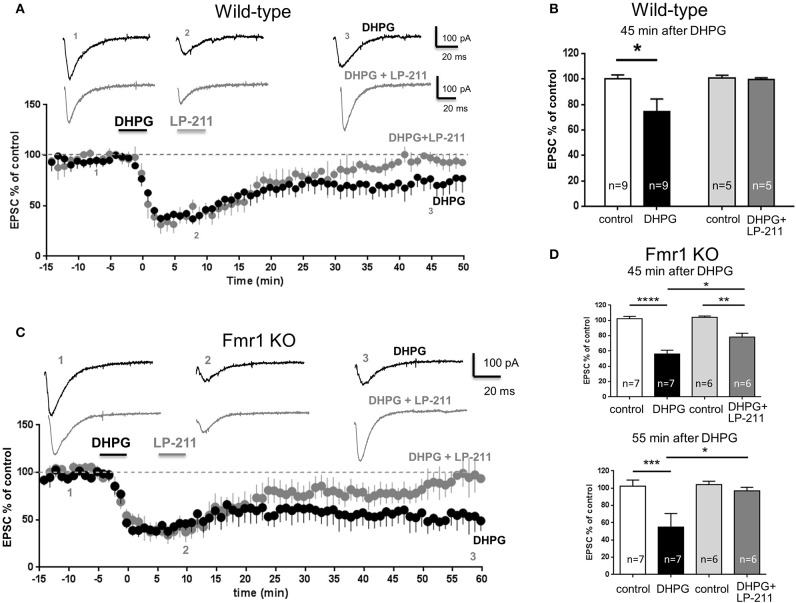Figure 2.
LP-211 reversed mGluR-LTD in the hippocampus of wild-type and Fmr1 KO mice. Excitatory post-synaptic currents (EPSCs) mediated by AMPA receptors were recorded under whole-cell patch clamp from CA1 pyramidal neurons after stimulation of Schaffer collaterals in the continuous presence of the NMDA receptor antagonist D-AP5 (50 μM). EPSC amplitude is represented as percent of control EPSC amplitude prior to any substance application. Pooled data of % EPSC values (mean ± SEM) were plotted vs. time; insets show individual EPSC traces from representative experiments. (A) Hippocampal slices (300 μm) were prepared from wild-type mice on a C57BL/6J background (PN 14-21). Bath application of DHPG (100 μM, 5 min), an agonist of group I metabotropic glutamate receptors, induced a long term depression of EPSC amplitude. In another group of recordings, LP-211 (10 nM, 5 min) was applied 5 min after LTD induction. Following application of LP-211, EPSC amplitude returned to control values (100%), indicating that mGluR-LTD was reversed. (B) Histograms show mean EPSC amplitude values (% of control) in control conditions (empty column, n = 9) and 45 min after application of DHPG alone (black column, n = 9) or application of DHPG followed by LP-211 (dark gray column, n = 5). Application of DHPG significantly reduced EPSC amplitude (*P < 0.01), thus induced mGluR-LTD. Vice-versa, when DHPG application was followed by LP-211, EPSC values were not reduced with respect to control, indicating that mGluR-LTD was completely reversed. (C) Hippocampal slices were prepared from Fmr1 KO mice (C57BL6J strain; PN 14-21) Application of DHPG (100 μM, 5 min) induced a long-term depression (mGluR-LTD) of EPSC amplitude. When LP-211 (10 nM, 5 min) was applied after DHPG, mGluR-LTD was partially reversed. A complete reversal of mGluR-LTD was observed around 55 min after LTD induction. (D), upper panel: EPSC current amplitude in control conditions (100%) and 45 min after application of DHPG. In slices from Fmr1 KO mice, the amount of mGluR-LTD induced by DHPG alone was highly significant (black column; ****P < 0.00001) and was larger than in wild-type (compare with panel B). When DHPG application was followed by application of LP-211, the amount of mGluR-LTD was still significant (**P < 0.001) but was significantly reduced (*P < 0.01) with respect to mGluR-LTD induced by DHPG alone, indicating that mGluR-LTD was partially reversed. (D) Lower panel: EPSC current amplitude in control conditions (100%) and 55 min after application of DHPG: mGluR-LTD was completely reversed by LP-211, indicating a slower time course of LP-211-mediated reversal in Fmr1 KO with respect to wild-type.

